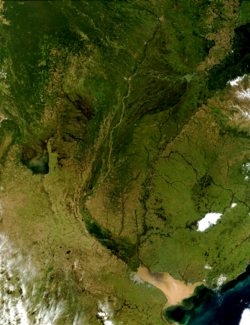Río de la Plata Basin
Río de la Plata Basin
Platine Region | |
|---|---|
Basin | |
 The southern Platine region viewed from space, with the Río de la Plata at the lower-right | |
 Map of the Río de la Plata basin in South America, with major cities and rivers marked | |
| Coordinates: 32°15′S 59°30′W / 32.250°S 59.500°W | |
| Location | South America |
| Area | |
| • Total | 3,170,000 square kilometres (1,220,000 sq mi) |
| Major rivers | Río de la Plata, Paraná River, Uruguay River, Paraguay River |
The Río de la Plata basin (Spanish: Cuenca del Plata, Portuguese: Bacia do Prata), more often called the River Plate basin in scholarly writings,[1] sometimes called the Platine basin[2] or Platine region,[3] is the 3,170,000-square-kilometre (1,220,000 sq mi)[4] hydrographical area in South America that drains to the Río de la Plata. It includes areas of southeastern Bolivia, southern and central Brazil, the entire country of Paraguay, most of Uruguay, and northern Argentina. Making up about one fourth of the continent's surface, it is the second largest drainage basin in South America (after the Amazon basin) and one of the largest in the world.[5]
The main rivers of the La Plata basin are the Paraná River, the Paraguay River (the Paraná's main tributary), and the Uruguay River.[6]
Geography
The La Plata basin is bounded by the
Politically, the basin includes part or all of the
Hydrology
The precipitation falling within this area is collected by numerous rivers to finally reach the Río de la Plata, almost all of it through the Paraná River, the Paraguay River, and the Uruguay River, La Plata's most important tributaries.[7] The river discharges water into the Atlantic Ocean at an average rate of 22,000 cubic metres per second (780,000 cu ft/s), the majority of which comes from the Paraná.
The basin serves as the recharge zone for the Guarani Aquifer, one of the world's largest aquifer systems. The rivers of the La Plata Basin carry an estimated 57,000,000 cubic metres (2.0×109 cu ft) of silt into the Río de la Plata each year, where the muddy waters are stirred up by winds and tides; the shipping route from the Atlantic to Buenos Aires is kept open by continual dredging.
Tributaries
The Paraná River's main tributaries include the
History
The Río de la Plata Basin has been the site of much conflict in the modern history of South America, much of it because the basin contained the (contested) frontiers between the Portuguese and Spanish Empires in South America and their successor states. A series of wars has been fought over territorial control in the region, particularly in the nineteenth century.
Early exploration
Explorer
Colonial period
The first European colony in the Platine region was the city of Buenos Aires, founded by Pedro de Mendoza on 2 February 1536. This settlement, however, was quickly abandoned; the failure to establish a settlement on the La Plata estuary led to explorations upriver and the founding of Asunción in 1537. Buenos Aires was subsequently refounded by Juan de Garay on 11 June 1580.[4]
During the colonial era because of the lack of precious metals, the Platine basin was largely neglected by the
Revolutionary period
Conflict in the region intensified after the independence of the former Spanish and Portuguese colonies in the first quarter of the 19th century. Territorial interests and navigation rights in the Platine region were at issue in many armed conflicts throughout the century, including the Argentine Civil Wars, the Cisplatine and Platine wars, and the Paraguayan War.[4]
21st-century
Economic features
Dams
There are several hydroelectric dams operating in the basin, among them the second largest operating facility in the world, Itaipu, shared between Paraguay and Brazil on the Paraná River; the 21st, Ilha Solteira Dam in Brazil, on the Paraná; the 25th, the Yacyretá Dam shared between Paraguay and Argentina, also on the Paraná; and the 53rd, the Itumbiara Dam in Brazil on the Paranaíba River.
Also on the Paranaíba in Brazil are the Emborcação and São Simão dams. On the Paraná in Brazil also are the Engineer Souza Dias and the Engineer Sérgio Motta dams.
On the
dams.On the Iguazu river in Brazil are the Bento Munhoz, Ney Braga, José Richa, Salto Santiago, and Salto Osório hydroelectric power plants. On the Pelotas river in Brazil, it is the Machadinho Hydroelectric Power Plant.
The Salto Grande Dam is on the Uruguay River and it is shared between Uruguay and Argentina. Also on the Uruguay River but in Brazilian territory is the Itá Hydroelectric Power Plant.
On the Negro River, in Uruguay, there are the Rincon del Bonete or Gabriel Terra Reservoir, and the Baygorria and Constitucion dams.
Regional culture
The dialect of Spanish spoken in the lower Río de la Plata basin is Rioplatense Spanish, named for the river. The Platine region is the birthplace of the tango dance and music.
References
- ^ The digital library JSTOR had 87 scholarly articles that used "River Plate basin" vs. 34 that used "Rïo de la Plata basin", accessed 27 June 2017.
- ISBN 978-0-8032-4786-4
- ISBN 978-1-5748-8450-0
- ^ a b c d e "Río de la Plata". Encyclopædia Britannica. Retrieved 11 August 2010.
- .
- ISBN 978-3-540-67228-9.
- ISBN 978-3-5407-4926-4
External links
- Association of American States: La Plata Basin (in Spanish)
- Map
- Cuenca del Plata at Monografías.com (in Spanish)
